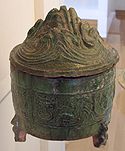Scented smoke burner
The incense burner ( Chinese博山 (香) 爐; Boshan (xiang) lu) is the name given to the vessels used in China for burning fragrant substances ( incense ).
Usage
The incense burner was used on the one hand for private contemplation by members of the upper class, but was also used for religious ceremonies. In southern China, they were sometimes given to the deceased along with other artefacts as grave goods on their last journey.
shape
Scented smoke burners first came into use during the Han Dynasty . At that time they mostly consisted of a goblet-shaped vessel with a lower bowl on which a conical lid was placed. This typically had the shape of a mountain, which was often depicted in great detail with rock walls and vegetation, sometimes even with people and animals. The smoke produced by the burning of herbs and resins in particular emerged through small openings in the mountain, which gave the observer the association with rising clouds of mist.
The popularity of the mountain shape is related to the traditionally great religious and mythological importance of mountains in the Chinese culture. In Taoism, for example, the Kunlun in the west is the abode of the goddess Xiwangmu and the origin of the peaches of immortality, while Mount Fenglai in the East Sea is the seat of the Eight Immortals. The destination of religious pilgrimages has always been the country's “Holy Mountains”, the most famous of which is the Tai Shan . After the establishment of Buddhism , the imaginary world mountain Meru was added.
In later times, the mountain-shaped lids of the incense burner were also used for other vessels, such as those for storing wine. Conversely, other lid shapes could also establish themselves with the scented smoke burners. Under the influence of Buddhism, the lotus bud , for example, became very popular - although it took up the rough shape of the mountain lids.
material
Because of their affinity for mountains, incense burners were usually made of materials of mineral origin; Various types of ceramics and earthenware were particularly common. On the other hand, pieces that were particularly valuable and ultimately only affordable for the nobility and wealthy civil servants' households were carved from a single piece of stone - which then represented the mountain from which it originated in miniature. For example, the leading scholar and artist of the Song era , Su Shi , is said to have owned a “ grotto sky stone” (洞天 石; dongtian shi) which, according to his description, had all the features of an incense burner with a mountain-shaped lid. Some outstanding pieces were also found in the holdings of the Qing Emperor Kangxi . Occasionally, incense burners made of metal were also made.
literature
- R. Daniel Schneiter: Boshan Xianglu - miniaturized mountains as objects of contemplation . In: Albert Lutz, Alexandra von Przychowski (ed.): Paths to paradise or the love of stone in China . Museum Rietberg, Zurich 1998, ISBN 3-907070-78-X ( The love of stone . Volume 1; exhibition catalog).

